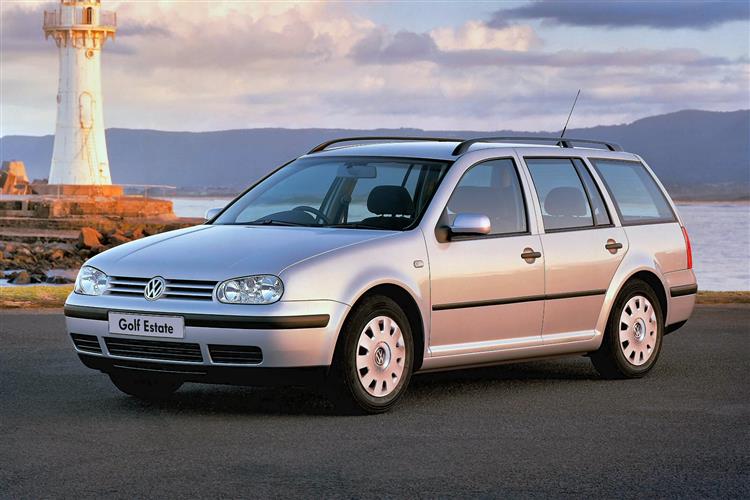ESTATE OF THE HEART (some text hidden) --NONE--
BY ANDY ENRIGHT
Introductionword count: 147
Ask most people what a Volkswagen Golf is and most will answer 'a hatchback', a few will proffer 'a convertible' but precious flew will plump for an estate car. The Golf Estate is a curious proposition when you pause to consider it. Here's a car that sells (in hatchback form at least) on the basis of its premium quality and image, yet in the MK IV estate guise we look at here, metamorphosed into a rather dull looking workhorse. Rather unsurprisingly, this resulted in rather unspectacular sales figures in the UK, with many prospective customers realising that a Skoda Octavia Estate offered many of the attributes of a Golf Estate in a far more affordable package. If you do have your heart set on the Volkswagen however, there is no shortage of models available, although tracking down your exact specification and/or colour may well take some time.
Modelsword count: 14
Models Covered: (5dr estate 1.4, 1.6, 1.8T, 2.0 petrol, 1.9 diesel [E, S, SE])
Historyword count: 194
Introduced in August 1999, the Mk IV Volkswagen Golf Estate was sold alongside its more popular hatchback and convertible siblings, offering those determined to buy Volkswagen a more practical solution. A huge array of engines was eventually offered including petrol options such as the 75bhp 1.4-litre 16v, the 100bhp 1.6 and the 115bhp 2.0-litre. A 150bhp V5 flagship version was initially offered then quickly dropped, replaced by a four cylinder 1.8T with identical power. Some were initially confused by the car's similarity to the Bora estate, a car which was offered for sale in many foreign markets but which Volkswagen wisely decided not to import to the UK. The brand equity in the Golf badge spelt potentially bigger sales for Volkswagen. August 2000 saw the 8-valve 100bhp petrol engine replaced by a 105bhp 16-valve unit. For the 2001 model year, Volkswagen replaced the 115bhp TDI engines with 130bhp units, kept the 90bhp diesels and reintroduced the 110bhp engines, previously deleted when the short-lived 115bhp Pump Duse engine came on stream. The TDi diesel range in the estates was reappraised at the end of 2001 to consist of 100 and 130 bhp Pump Duse variants.
What You Getword count: 511
For a start, this car has all the quality of its hatchback stablemate, a standard of fit and finish completely unrivalled in the family hatchback sector. At the wheel of a Golf hatch, you feel you're in something much more expensive. In the estate, it's the same. Not such a big step from here then, to BMW territory. Of course, it depends what model you buy. There's not much chance you'd imagine yourself behind the wheel of a 3 Series or an A4 seated in a base Golf Estate 1.4E. The boxy looks don't shout 'lifestyle' either, though standard roof rails help provide a purposeful look. At least Volkswagen has done the job properly with an estate conversion that makes this bodystyle 248mm longer than the standard hatchback. The rear doors for example, are unique to this model, ensuring that the extended rear compartment blends in smoothly with the rest of the car. If you own a MKIII Golf Estate, or one of its obvious rivals, you're more likely however, to be interested in the practicalities. Well, it's a mixed story. With its rear seats folded, the latest version has 1470 litres of luggage space - 45 litres more than its predecessor. However, with all the seats in use, the total volume (460 litres) has actually gone down slightly. The latest Golf wagon also lags slightly behind its Focus and Astra estate rivals in this respect - but beats them both for day-to-day practicality. For a start, there's a superbly flat squared off load bay with no suspension turrets intruding to restrict the width. There's also plenty of storage space for knick-knacks, with door bins and a useful under-floor stowage area above the spare wheel. Lidded panniers either side of the boot area house a first aid kit and the CD autochanger now standard on the V5 version. Other nice touches include four chrome lashing hooks to tie down awkward loads and a 12 volt power point housing in the boot wall. As you'd expect, the rear seats split-fold 60/40, though you have to remove the rear head restraints to fold them flat. At least there are designated places for them to go. The tailgate opening is wide and extends down into the bumper to give a low loading height. The sill is protected by a metal plate to protect the floor from wear and scuffing as heavy items are loaded and removed. Oh and you can specify bars that attach to the roof rails and allow you to carry skis, mountain bikes or an aerodynamically designed roofbox. All typical German attention to detail. The range of models on offer broadly reflects that of the standard hatchback (though there's no GTi variant). That means three trim choices (E,S and SE), plus that available for the top of the range 1.8T. This model includes fully automatic air conditioning, 16'' alloy wheels, a sports interior, automatic dimming rear view mirror, rain-sensing wipers, an alarm and all-round electric windows. Even entry-level E models however, come with twin front and side airbags, ESP and ABS.
To see the full road test text contact us on 0330 0020 227
Pictures (high res disabled)

Scoring (subset of scores)
Category: Spacious Family Cars
| Performance | |
| Handling | |
| Comfort | |
| Space | |
| Styling, Build, Value, Equipment, Depreciation, Handling, Insurance and Total scores are available with our full data feed. | |



